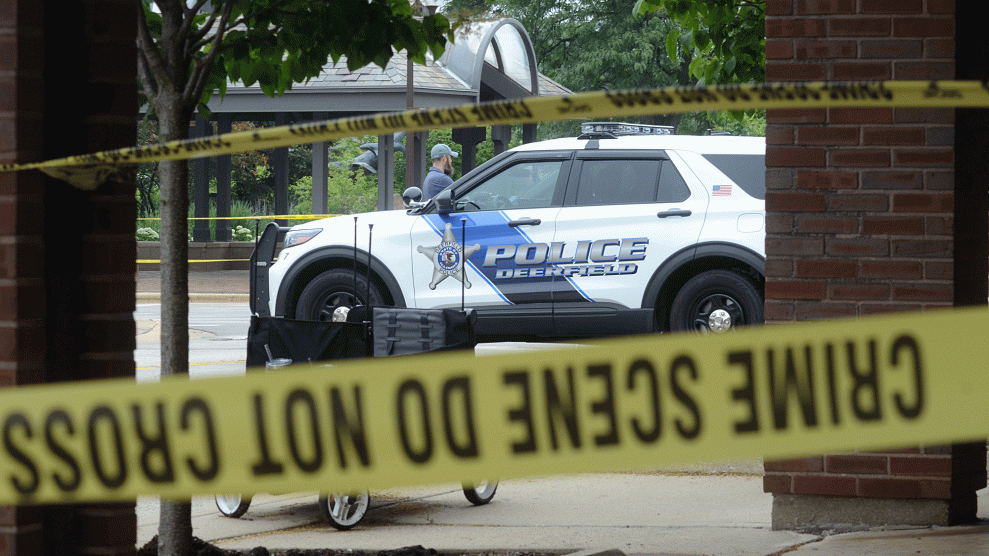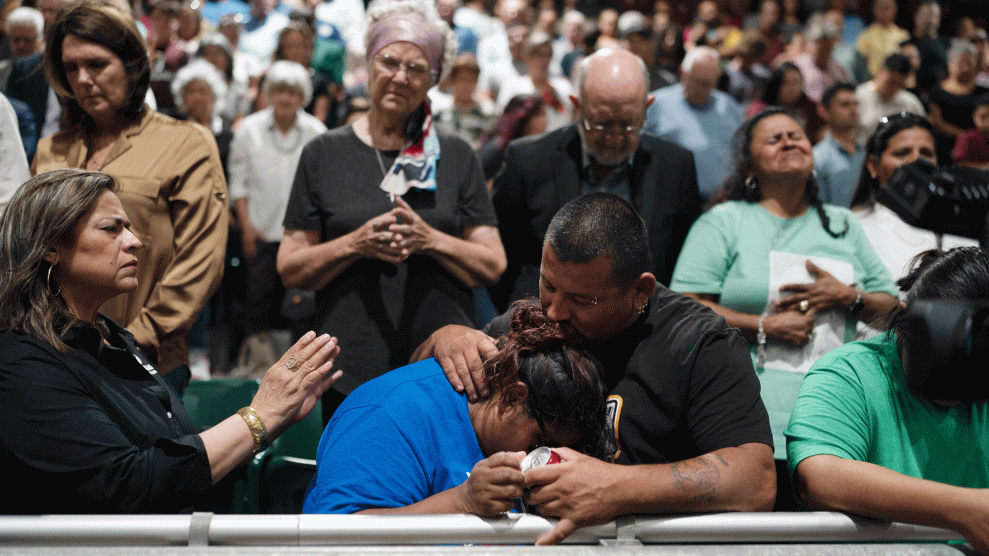
FBI officials clear debris from Central Ave. in Highland Park, Illinois, after a mass shooting at the Fourth of July parade.Jacek Boczarski/Getty
Before opening fire at a Fourth of July parade in Highland Park, the 21-year-old gunman presented clear warning signs that he posed a risk to himself and others: He had reportedly experimented with self-harm and attempted suicide, according to family friends. He also threatened “to kill everyone” in 2019, according to state police, leading officers to confiscate more than a dozen knives from his home.
A 2019 case in South Florida shares a similar origin story: A young man told a doctor “there were some people he wanted to kill,” prompting the physician to admit the patient, who had intellectual deficits, on a psychiatric hold. While in the hospital, staff found a receipt in his pocket for a semiautomatic rifle, South Florida active duty threat-response detective Christopher Carita tells Mother Jones.
But the two stories have distinctly different endings. The young man in Illinois was able to legally obtain multiple firearms that he used in an attack killing seven people and injuring dozens more earlier this month. The young man in Florida was not.
Instead, the Florida man was served with an Extreme Risk Protection Order (ERPO), which blocked him from picking up the semiautomatic rifle that he had already purchased (the state has a three-day waiting period) and from purchasing a second gun when he later tried again. He went on to receive the mental health help he needed, which resulted in him articulating to a therapist why he wanted to buy guns in the first place: The man had repeatedly been robbed on the way home from his construction job and thought that shooting the thieves was the best way to deal with them. Thanks to the ERPO, he never got his hands on a gun to kill them.
Nineteen states, including both Illinois and Florida, have so-called “red flag” laws, which enable people—usually law enforcement officers and immediate family members—to petition a state judicial system for ERPOs that block individuals posing a clear danger to themselves or others from buying guns and remove existing guns from their possession. In response to recent mass shootings at a Buffalo, New York, grocery store and a Uvalde, Texas, elementary school, Congress passed its first major bipartisan gun control legislation in more than 20 years in June. The bill included nearly a billion dollars in funding to help states create or expand their own red flag laws.
The mere existence of red flag laws, however, isn’t enough to stop mass shootings and firearm-involved suicides. Illinois’ red flag law, which took effect in 2019, didn’t prevent an individual presenting common warning signs from committing the Highland Park shooting. Indeed, the law is seldom invoked there: Only one county in Illinois filed more than two ERPOs per year in 2019 and 2020, according to the Illinois Criminal Justice Information Authority.
Nor did New York state’s red flag law prevent the racially motivated mass shooting in Buffalo that left 10 Black people dead in May. Though the suspected gunman in that case had previously threatened a mass shooting, he was also able to legally purchase firearms. There was limited application of ERPOs in the shooter’s home county of Broome, New York, which filed only 11 ERPOs since New York state passed its red flag law in 2019, according to data obtained by the New York Times. (Other New York counties have issued upward of 16 times as many ERPOs, according to local outlet the City).
When used efficiently, ERPOs can be a revolutionary tool to keep communities safe. “Most policing models have been reactive. You have a pattern of crime, whether it’s shootings or otherwise, and you task more officers with investigating or flooding that area,” says Carita, who helped facilitate the ERPO in the South Florida case. “This is the first time where I had the opportunity to investigate each situation and try to mitigate violence before it gets worse—before somebody gets hurt.”
But red flag laws are only effective if law enforcement knows how to use them, and right now that is not consistently the case.
There is “tremendous variation that exists across states, as well as within states,” says Shannon Frattaroli, a Johns Hopkins professor and member of the university’s Center for Gun Violence Solutions. “It’s not uncommon to see counties in states with zero ERPOs and then other counties that are finding ways to use them at very high rates.”
The Bipartisan Safer Communities Act, which President Joe Biden signed into law on June 25, included $750 million worth of funding to help states change that.
Imitating Maryland’s successful ERPO training method is one way states could use the money to improve their ERPO practices. After Maryland passed its red flag law in 2018, it had just six months to educate 17,000 law enforcement officers on how and when ERPOs should be applied. In that window, Montgomery County Sheriff Darren Popkin led workshops with representatives from all 150-plus law enforcement agencies in the state, who returned to their hometowns to train their own team members before the law took effect. Since the trainings, the state has incorporated ERPO education into its orientation programs for new police hires, and Maryland is now averaging around 700 to 800 ERPOs per year—the second-highest usage rate, per capita, behind Florida, which passed a red flag law after the Marjory Stoneman Douglas High School shooting in Parkland.
Popkin credits the training model for the state’s widespread use of ERPOs. So does Frattaroli, who is currently studying Maryland’s use of ERPOs in a multistate analysis. “One of the key explanations behind [the variation of ERPO usage] is the existence of what you might call a champion: someone who is in a position that can either implement these laws or influence the agencies and organizations that have the ability to use them,” she says.
States could also use the congressional funding to hire a dedicated ERPO advocate like Seattle has done. Seattle ERPO advocate Alyssa Shaw, the first government-supported ERPO advocate in the country, spends her days communicating with the families of individuals under ERPOs, ensuring that they understand the legal process and that the affected individual has access to mental health resources. “Law enforcement just doesn’t have the time and resources to give that kind of advocacy,” says Shaw. “That’s where I can step in.”
Shaw also works with Kimberly Wyatt, a senior deputy prosecuting attorney for King County, to educate physicians, mental health professionals, schools, and faith-based groups about ERPOs so they can go to the police and request them should the need arise. “What you’ll see across the country is that legislatures pass these [red flag] laws, and you’ll see widespread support for them, but they’re widely unknown,” says Wyatt. “You have to make sure that there’s an education component.”
As a result of these actions, Seattle’s surrounding King County has historically issued more ERPOs than other counties in Washington state, Wyatt says.
Most states with red flag laws, including Washington, allow only law enforcement officers and household family members to petition a judge for ERPOs.
But others can be involved in the process. Health care providers like psychiatrists can play an especially important role in identifying people who pose a risk to themselves or others and informing police, who can then petition for an ERPO. Later, the health professional can submit paperwork, evidence, and testimony to help get the ERPO granted by a judge.
A problem with this model, however, is that medical professionals often don’t have time to participate in what can be a lengthy process of hearings and paperwork. One solution that has not yet been tried, says Frattaroli, is states hiring what she calls “clinical navigators,” or medical professionals whose sole job will be to work alongside patients’ regular health care teams to advance the ERPO process through the judicial system when necessary.
Her argument is simple: The more people who know about ERPOS and are engaged in the ERPO process, the more effective they will be.
“ERPOs only have the potential to make a difference—to promote community safety, to stop shooters like the one in Illinois,” Frattaroli says, “if they’re used.”












